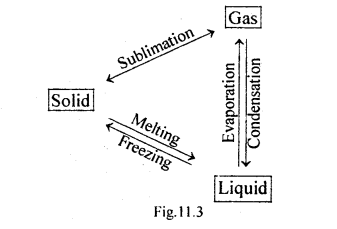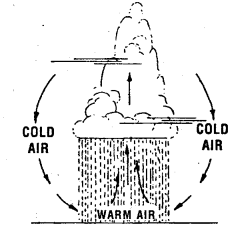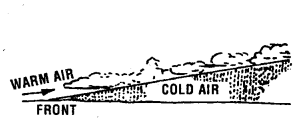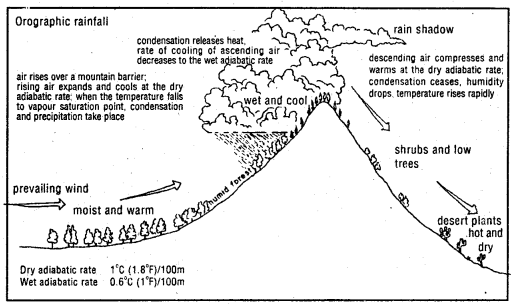Here we are providing Class 11 Geography Important Extra Questions and Answers Chapter 11 Water in the Atmosphere. Important Questions for Class 11 Geography are the best resource for students which helps in class 11 board exams.
Important Questions for Class 11 Geography Chapter 11 Water in the Atmosphere
Water in the Atmosphere Important Extra Questions Very Short Answer Type
Question 1.
What is the greatest source of atmospheric moisture?
Answer:
The surface of the ocean is the greatest source of atmospheric moisture.
Question 2.
What is meant by humidity?
Answer:
The state of the atmosphere with respect to its content of moisture or water vapour is called humidity.
Question 3.
What is meant by sensible temperature?
Answer:
It is the cold or heat felt by the human body, depending not only on actual temperature but also on relative humidity and wind.
Question 4.
Name three states in which water exists.
Answer:
Water exists in three states or forms:
- Solid (ice),
- Liquid (water),
- Gas (water vapour).
Question 5.
What is the measure of absolute humidity?
Answer:
Absolute humidity is measured in grams per cubic metre (g/m3).
Question 6.
What is the dew point?
Answer:
It is the temperature at which air, on cooling, becomes saturated with water vapour, and below which condensation begins and dew forms.
Question 7.
Why dew and frost form on grass quite readily?
Answer:
Because grass is a good radiator and, therefore, cools quickly.
Question 8.
Identify various forms of precipitation.
Answer:
Various forms of precipitation include rainfall, snowfall, hail, sleet and drizzle.
Question 9.
Name three types of precipitation.
Answer:
The three types of precipitation are convectional, orographic and cyclonic precipitation.
Question 10.
How does precipitation take place?
Answer:
Precipitation takes place as a result of the continued condensation and growth of the moisture particles until they become too large to remain suspended in the air.
Question 11.
What is the source of atmospheric moisture?
Answer:
The oceanic surface is the main source of atmospheric moisture.
Question 12.
Which factors control evaporation?
Answer:
There are three main factors which control evaporation:
- aridity,
- temperature,
- movement of air.
Question 13.
Name the various types of clouds.
Answer:
Cirrus clouds, stratus clouds, stratocumulus and cumulus clouds.
Question 14.
What are the different types of fog?
Answer:
Fogs are of three types: radiating, advection and frontal fog.
Question 15.
What is condensation?
Answer:
Cooling of saturated air is called condensation.
Question 16.
What are the different types of rainfall?
Answer:
Rainfall is of three types: convectional, orographic and cyclonic rainfall.
Question 17.
What is sublimation?
Answer:
The process of conversion of ice into liquid or vapour is known as sublimation.
Question 18.
Name the temperature at which a given sample of air becomes saturated.
Answer:
Dew point.
Question 19.
What do you mean by saturated air?
Answer:
The air that contains moisture to full capacity.
Question 20.
What is relative humidity?
Answer:
The ratio of the amount of water vapour actually presents in the air at a particular temperature to the amount of water vapour required to saturate the same air at the same temperature.
Question 21.
What is sleet?
Answer:
The falling of frozen raindrops and frozen melted snow on the earth’s surface is known as sleet.
Question 22.
Name the various types of humidity.
Answer:
Absolute humidity, specific humidity and relative humidity.
Water in the Atmosphere Important Extra Questions Short Answer Type
Question 1.
Describe various processes involved in the change of state (form) of water.
Answer:
Water exists in three forms, solid (ice), liquid (water) and gas-(vapour). All three states are interchangeable. The change of solid to ‘ liquid is called melting; from liquid to solid is freezing; from liquid to gas is evaporation and from gas to liquid is condensation. But sometimes ice directly converts into vapour or vice-versa. This is called sublimation.

Question 2.
Describe various sources of atmospheric moisture on the earth.
Answer:
The surface of the ocean is the greatest source of atmospheric moisture. Besides, smaller water bodies, vegetation and damp surfaces also contribute significant amounts of moisture.
Question 3.
What is relative humidity and how is it measured?
Answer:
The amount of water vapour in the air compared with the amount that would be present if the air was saturated at that temperature. It is expressed in percentage determined by dividing the absolute humidity by water holding capacity of air. If the air is saturated, its relative humidity is 100%; if only half saturated, the relative humidity. is 50%. Since the capacity of air for absorbing and retaining moisture varies with temperature, the relative humidity of air mass can be altered by merely lowering its temperature without changing the actual amount of moisture present in it.
Question 4.
Discuss the reasons which impede the formation of dew or frost.
Answer:
On cool nights in early winter, when Radiation from the ground is relatively rapid, the air in contact with the ground may be chilled to the dew point and moisture condenses on the leaves and grass in the form of dew. If the dew point is below the freezing point, the condensation takes place in the form of ice crystals or frost. The formation of dew or frost is impeded by
- Dry air,
- Wind mixes the air and prevents its lower portion from reaching the dew point, and
- Clouds which slow down terrestrial radiation.
Question 5.
What are the middle clouds?
Answer:
The clouds which form at height of2000-7000 km. above the ground are called middle clouds. Altostratus and altocumulus are examples.
Altostratus – It is a uniform sheet of cloud, grey or bluish in colour and usually has a fibrous structure.
Altocumulus – These are flattened globular masses of clouds arranged in lines or waves. They have large globules with shadows.
Question 6.
Why does the amount of water vapour decrease rapidly with altitude?
Answer:
Water vapour in the atmosphere is the result of the evaporation of water from the earth’s surface, a continual process dependent on air. Since the air becomes thinner with the altitude, so also does the water vapour.
Question 7.
What is condensation and how does it take place?
Answer:
Condensation is the process of water vapour changing to a liquid state. If the air is cooled below its dew point, some of the air’s water vapour becomes liquid. Thus, any amount of cooling of saturated air starts the process of condensation. Condensation may start with the addition of any further water vapour to the saturated air, or with the reduction of its temperature.
Question 8.
What is precipitation? What are the conditions to determine the form of precipitation?
Answer:
Precipitation is a process of condensation of water vapour in ‘ the atmosphere which falls to the earth in the form of rain, snow, hail or sleet. These are the various forms of precipitation.
Conditions for precipitation.
- There should be evaporation so that the relative humidity is „ high in the air.
- There should be adiabatic cooling of the moist air.
- There should be dust particles in the air.
Question 9.
What are the effects of humidity?
Answer:
The main effects of humidity are:
- The skin of the human body starts to crack due to low relative humidity.
- It causes joint pain in the human body.
- The high relative humidity is harmful to the human body.
- The joints of furniture get loosened.
Question 10.
Why does the amount of water vapour decrease rapidly with altitude?
Answer:
The amount of water in the atmosphere is variable from place to place and from time to time. It decreases rapidly with altitude. The temperature decreases as the altitude increases.
Question 11.
How is rainfall caused?
Answer:
The moist air is cooled, saturated and condensation takes place. Water vapour condenses on a large number of dust particles to form clouds.
The cloud droplets merge to form raindrops. When these raindrops become so heavy that air cannot hold them, these fall on the earth in the form of rainfall. The release of moisture in the form of drops of water is called rainfall.
Question 12.
Describe the conditions for the formation of dew.
Answer:
Following are the favourable conditions for the formation of dew:
- Clear sky
- Calmness, i.e., the wind should not blow
- High relative humidity
- Rich vegetation cover
- Long nights
Water in the Atmosphere Important Extra Questions Long Answer Type
Question 1.
Distinguish between:
1. Relative humidity and Absolute humidity.
2. Evaporation and Condensation.
3. Dew and Frost.
Answer:
1. Relative humidity and Absolute humidity:
Relative humidity:
The amount of water vapour in the air compared with the amount that would be present if the air was saturated at that temperature. It is expressed in percentage determined by dividing the absolute humidity by water holding capacity of air. If the air is saturated, its relative humidity is 100%; if only half saturated, the relative humidity. is 50%. Since the capacity of air for absorbing and retaining moisture varies with temperature, the relative humidity of air mass can be altered by merely lowering its temperature without changing the actual amount of moisture present in it.
Absolute humidity:
It is the actual amount of water vapour present per unit volume of air and it is measured in grams per cubic meter.
2. Evaporation and Condensation
Evaporation is the process by which a solid or liquid is converted to a gaseous state or vapour. It occurs whenever energy is transported to an evaporated surface and temperature rises. The molecules become more mobile and overcome the forces binding them to the water surface and break away resulting in evaporation.
Condensation:
Condensation is the process of water vapour changing to a liquid state. If the air is cooled below its dew point, some of the air’s water vapour becomes liquid. Thus, any amount of cooling of saturated air starts the process of condensation. Condensation may start with the addition of any further water vapour to the saturated air, or with the reduction of its temperature.
3. Dew and Frost:
Dew: When the moisture is deposited in the form of water droplets on cooler surfaces of solid objects, such as stones, grass blades and plant leaves, it is known as dew. Clear sky, calm air, high relative humidity, cold and long nights are the ideal conditions for the formation of dew.
Frost: Frost forms on cold surfaces at a dew point which is at or below the freezing point when an excess of moisture is deposited in the form of minute ice crystals instead of droplets of water.
Question 2.
Write short notes on:
(a) Convectional precipitation
(b) Cyclonic precipitation
(c) Orographic precipitation
Answer:
(a) Convectional precipitation:
It occurs when moist air over the heated ground becomes warmer than the surrounding air and is forced to rise, expand, cool and yield some of its moisture.
Convectional rain is common in low latitudes and usually comes in the form of short heavy showers, often during the hottest part of the day. Thunder and lightning generally accompany the showers. If the convection currents are especially strong and turbulent, hail is formed.

(b) Cyclonic precipitation:
It occurs in low-pressure areas, where cyclonic winds coming from various directions converge and force the large volumes of light air to rise and cause rain.
Cyclonic precipitation is generally associated with the passage of depression in middle or high latitudes, as the warm moist air mass of the depression rises and over-rides colder, heavier air.

(c) Orographic precipitation:
It is caused due to relief. It occurs when the moist wind is forced to rise over a mountain or any other height. Precipitation occurs due to cooling of moisture-laden air as it rises over a high relief barrier. It happens, particularly on the windward slopes! On the other side of the barrier or on the leeward side of the slopes, there develops rain shadow area with no or very little rainfall because as the moisture-laden wind descends down the slope, after precipitating on the windward side, it becomes warmer and drier. Such a situation occurs along the western coasts of Qudra, North America and South America. The moist air from the Arabian Sea is forced by Sahyadri hills of the Western Ghats to rise up resulting in expansion, cooling and rainfall.
Amount of precipitation depends on slope, the height of the hills, temperature and moisture content of the air mass. On the other side of the mountain, the descending wind is devoid of moisture and, hence, does not give rain. The eastern slope of Sahyadri mountains in India falls in the rain shadow area.

Question 3.
Describe the factors controlling the rate of evaporation and evapotranspiration.
Answer:
vaporation is the process by which liquid water or ice changes into water vapour. It occurs whenever energy is transported to an evaporated surface and temperature rises. The molecules become more mobile and overcome the forces binding them to the water surface and break away resulting in evaporation.
Evapotranspiration, on the other hand, is the amount of moisture transferred to the atmosphere by evaporation of liquid and solid water plus transpiration from living tissues principally from the plants.
Factors like the temperature of the air, source of moisture, vegetation cover, latitude, permeability and water retention effect evaporation and evapotranspiration.
Evaporation depends upon air temperature. Greater the temperature, higher is the rate of evaporation and so on. Therefore, the highest rate of evaporation occurs in deserts in conditions Of great heat and lack of surface cone.
The surface of oceans is the greatest source of atmospheric moisture.
Vegetation is an important factor, particularly in evapotranspiration. Because, under transpiration, the loss of water takes place from the green plants resulting in a stream of water with dissolved mineral salts surfing up through the plants.
Question 4.
Describe the various forms of precipitation and the major precipitation regimes of the world.
Answer:
Precipitation results from the continued condensation and growth of the moisture particles until they become too large to remain suspended in the air.
If condensation takes place at a temperature above 0°C, the resulting precipitation is in the form of rain.
If the process through a layer of colder air on the way down, it may freeze and fall as sleet.
In a strong turbulent current of a thunderstorm, water drops may be carried upward into freezing temperatures and eventually fall as hail. In fact, violent air currents may keep hailstones shuttling up and down until they grow to enormous sizes.
When the more. moisture crystallises into ice particles from vapour at a temperature below freezing point, it called snow. If snowflakes grow without interference, they form beautiful symmetrical, six-sided Crystals.
Ice-storms result when rain, already near the freezing point, falls on colder ground and vegetation and freezes upon contact.
Major precipitation regimes:
(a) Convectional precipitation:
It occurs when moist air over the heated ground becomes warmer than the surrounding air and is forced to rise, expand, cool and yield some of its moisture.
Convectional rain is common in low latitudes and usually comes in the form of short heavy showers, often during the hottest part of the day. Thunder and lightning generally accompany the showers. If the convection currents are especially strong and turbulent, hail is formed.

(b) Cyclonic precipitation:
It occurs in low-pressure areas, where cyclonic winds coming from various directions converge and force the large volumes of light air to rise and cause rain.
Cyclonic precipitation is generally associated with the passage of depression in middle or high latitudes, as the warm moist air mass of the depression rises and over-rides colder, heavier air.

(c) Orographic precipitation:
It is caused due to relief. It occurs when the moist wind is forced to rise over a mountain or any other height. Precipitation occurs due to cooling of moisture-laden air as it rises over a high relief barrier. It happens, particularly on the windward slopes! On the other side of the barrier or on the leeward side of the slopes, there develops rain shadow area with no or very little rainfall because as the moisture-laden wind descends down the slope, after precipitating on the windward side, it becomes warmer and drier. Such a situation occurs along the western coasts of Qudra, North America and South America. The moist air from the Arabian Sea is forced by Sahyadri hills of the Western Ghats to rise up resulting in expansion, cooling and rainfall.
Amount of precipitation depends on slope, the height of the hills, temperature and moisture content of the air mass. On the other side of the mountain, the descending wind is devoid of moisture and, hence, does not give rain. The eastern slope of Sahyadri mountains in India falls in the rain shadow area.

Question 5.
Why dew is not formed on cloudy, windy nights and in shady places?
Answer:
Dew is formed when objects radiate heat thoroughly so that the moist air coming into contact with them may be sufficiently cooled down and the water vapour condenses into water droplets. The clouds act as a blanket for the earth’s surface. They check the radiation of heat so it does not radiate heat thoroughly. Hence, dew is not formed on cloudy nights and in shady places.
Similarly, dew is not formed on windy nights, because the winds blow fast and the moist air does not come long enough into contact with cold objects to get cooled. Hence, condensation does not take place and no dew can be formed.